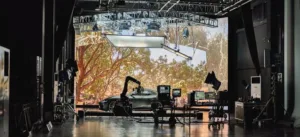Omdia is predicting significant growth in the Virtual Production (VP) market, forecasting that total revenue will soar from $138.7 million in 2023 to over $1.1 billion by 2028. This growth is attributed to the expanded use of VP in filmmaking and its emerging applications in corporate and educational settings.

Virtual production, which integrates physical and digital elements in real-time, allows filmmakers to create immersive environments on set. This technique uses advanced technologies such as high-resolution LED walls, motion tracking, and virtual cameras to capture live-action scenes against digital backdrops. This enables immediate visual and compositional adjustments during filming, offering clear advantages over traditional green screen technologies.
Omdia acknowledges that while VP’s benefits in filmmaking are relatively established, its use in non-entertainment sectors like corporate training, marketing, and education is still developing. Companies like SmartStage and Vū are leading the adoption in corporate environments by providing simplified, subscription-based solutions that enhance training and collaboration.
The analysis also outlines a promising market for LED vendors, driven by the growing demand for VP technologies across various sectors, including education and corporate settings. The projected annual growth rates for these sectors are 130% and 111% respectively, from 2023 to 2028. This demand is expected to increase the revenue from LED hardware specifically for virtual production from $73.5 million in 2023 to $513.2 million in 2028.
ROE Visual and AOTO as early leaders in the LED market for VP, holding significant market shares. However, the competition is increasing as other companies like InfiLED, Sony, and SiliconCore intensify their market strategies. The industry is also moving towards greater standardization, including adopting specific pixel pitches and enhancing display features to support the robust needs of virtual production.
The report suggests that AI will play a crucial role in advancing VP technology by optimizing tasks such as rendering and animation, which will improve efficiency and reduce production timelines. AI and machine learning are expected to enhance predictive analytics, aiding in better decision-making during production planning.

